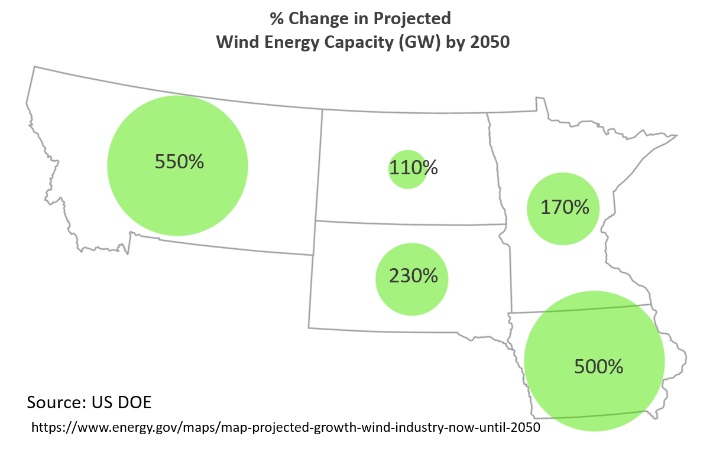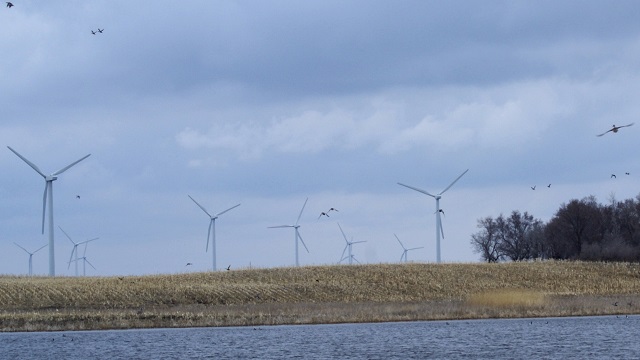Wind energy is a valuable and growing sector of renewable energy throughout the Great Plains that provides important environmental benefits, including the reduction of greenhouse gas emissions (GHG). Despite these benefits, there is the potential for direct, negative effects to birds and other wildlife from collisions with turbines. Perhaps more importantly for many birds, indirect effects also occur through behavioral displacement as well as lower habitat quality from landscape fragmentation.
 Meeting ambitious targets for GHG emission reductions in the U.S. will result in a large increase in wind energy development by mid-century. The U.S. Department of Energy has established a national vision for wind energy to provide at least 35% of the Nation’s electrical demand by 2050. The Prairie Pothole Region (PPR) and Northern Great Plains are projected to experience substantial wind energy growth over the next several decades, and an increase of over 350% in wind energy capacity may be likely.
Meeting ambitious targets for GHG emission reductions in the U.S. will result in a large increase in wind energy development by mid-century. The U.S. Department of Energy has established a national vision for wind energy to provide at least 35% of the Nation’s electrical demand by 2050. The Prairie Pothole Region (PPR) and Northern Great Plains are projected to experience substantial wind energy growth over the next several decades, and an increase of over 350% in wind energy capacity may be likely.
Because energy development is an additional form of grassland and wetland habitat loss in the PPR, its projected expansion increases the potential for cumulative effects to birds. These effects may be substantial for some species, especially since many of the PPJV’s priority grassland bird species are already experiencing dramatic declines. Coordinated efforts are needed to encourage energy development in areas that will have relatively low effects on birds. Also, providing compensatory habitat based on biological values is needed to offset habitat loss when effects from energy development are unavoidable.
This level of coordination is challenging not only because each of the five PPR states has different regulatory guidelines, but also because the effects of energy development on birds are highly variable across species, time of year, and spatial scales. These challenges have long been an important discussion among PPJV partners. Recently, the PPJV evaluated the current science and tools to inform energy development and provide recommendations for responsible development that are shared among the partnership.
The PPJV partnership has made – and continues to make – substantial science investments to understand the effects of energy development on priority birds in the region. This science spans across grassland and wetland birds as well as breeding and migration portions of the annual cycle. Throughout the Technical Committee’s evaluation, the high variability of resource concerns at local scales was an important and consistent theme among partners. Therefore, early engagement between industry and State Fish and Wildlife Agencies (SFWA) is seen as the greatest opportunity to develop projects that limit conflicts with birds and other wildlife and to support sustainable energy development.
These assessments led to the conception of the Guiding Principles for Wind Energy Development. This suite of guiding principles is intended to convey common elements among PPJV partners and help facilitate coordination that supports bird-friendly wind energy development in the region. Overall, they reflect the positive values of early engagement with SFWAs to capitalize on the wealth of local knowledge and science-based tools. Doing so will help projects minimize effects on birds and also help stakeholders achieve optimal outcomes for sustainable energy development in the PPR. Learn more about this work through the following resources:
- Guiding Principles for Wind Energy Development
- Wind Energy: Seven Guiding Principles for Bird Friendly Development (factsheet)
GUIDING PRINCIPLES FOR WIND ENERGY DEVELOPMENT
- Consultation and coordination with State Fish and Wildlife Agencies as early as possible in the exploration of siting for wind energy projects can help avoid or minimize unintended effects on birds and their habitats.
- Wind energy infrastructure has direct and indirect effects on birds and concerns for species and their habitats will vary by localities and seasonally.
- Consider priority bird species and their habitats, which will vary by locality, when siting wind energy projects and designing offsets.
- Encourage wind energy development in areas with relatively low effect to birds.
- Collaborative approaches led by natural resource agencies for siting wind development projects and designing offsets can help achieve optimal project outcomes among stakeholders.
- Design offsets for wind turbine infrastructure effects based on biologically-equivalent habitat values for birds.
- The PPJV partnership is committed to developing, providing, and using regional species-habitat models and decision-support tools that provide a consistent, transparent, and scientific basis for evaluating and minimizing biological effects of wind energy infrastructure on priority bird species.

